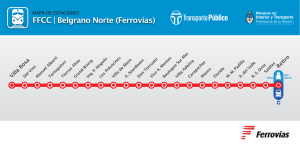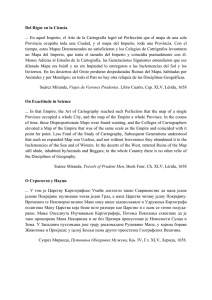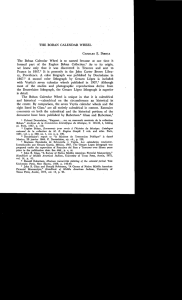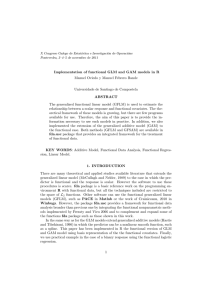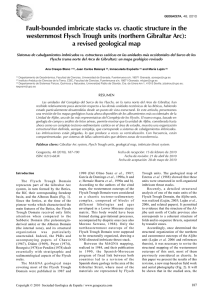curso uam 2013
Anuncio
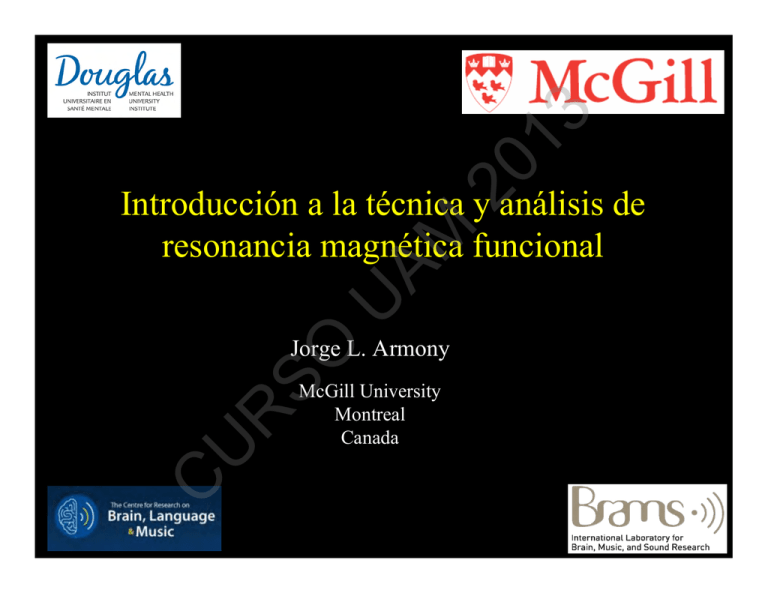
20 13 U AM Introducción a la técnica y análisis de resonancia magnética funcional C U R SO Jorge L. Armony McGill University Montreal Canada Potencial de acción C U R SO U AM 20 13 Interacciones neuronales Kandel, Schwartz & Jessel: Principles of Neural Science 20 13 Técnicas de neuroimagen funcional: Señal electrodinámica Electrodos de profundidad AM Electroencefalografía (EEG) C U R SO U Magnetoencefalografía (MEG) 20 13 C U R SO U AM Técnicas de neuroimagen funcional: Señal hemodinámica 20 13 AM J Physiol. (1890), 11: 85-158 C U R SO U These facts seem to us to indicate the existence of an automatic mechanism by which the blood-supply of any part of the cerebral tissue is varied in accordance with the activity of the chemical changes which underlie the functional action of that part. C U R SO U AM 20 13 Resonancia magnética funcional (IRMf/fMRI) Iron SO U AM 20 13 La hemoglobina C U R - four globin chains - each globin chain contains a heme group - at center of each heme group is an iron atom (Fe) - each heme group can attach an oxygen atom (O2) 20 13 AM PNAS (1936), 22: 210-216 Over ninety years ago, on November 8, 1845, Michael Faraday investigated the U magnetic properties of dried blood and made a note "Must try recent fluid blood." If he had determined the magnetic susceptibilities of arterial and venous blood, he SO would have found them to differ by a large amount (as much as twenty per cent for completely oxygenated and completely deoxygenated blood); this discovery R without doubt would have excited much interest and would have influenced C U appreciably the course of research on blood and hemoglobin. 20 13 Hemoglobin: Magnetic Properties AM Oxy-Hb (four O2) is diamagnetic → no ΔB effects Deoxy-Hb is paramagnetic → if [deoxy-Hb] ↓ → local ΔB ↓ B0 C U R SO U Oxyhemoglobin Diamagnetic χ ~ -0.3 oxyHb deoxyHb Deoxyhemoglobin Paramagnetic χ ~ 1.6 AM oxyHb deoxyHb 20 13 Hemoglobin: Magnetic Properties C U R SO U B0 20 13 neuronal activity ↑ tissue energy demand ↑ neurovascular coupling AM Glucose, O2 consumption ↑ fMRI relevant physiological correlates SO U blood flow and volume ↑ R local dHb content of blood ↓ C U local dHb-induced magnetic field disturbance ↓ BOLD fMRI signal ↑ (Blood Oxygen Level Dependent signal) Source: B. Pike, MNI C U R SO U AM 20 13 Relationship between BOLD signal and neural activity LFP: local field potentials MUA: multiunit activity SDF: Spike density function Logothetis et al. (2001). Nature 412: 150-157 C U R SO U AM 20 13 First Functional Images 13 Kwong et al. (1992) PNAS 89: 5675-5679 C U R SO U AM 20 13 Hemodynamic response 14 Source: Robert Cox’s web slides 1 13 25 19 AM 20 13 7 30 slices VOXEL (Volumetric Pixel) Un volumen: 64 x 64 x 30 voxels 4 mm U R 4 mm Resolution in x (e.g. 4mm) 24 U SO Matrix in the xy plane (e.g., 64 x 64) 4 mm C Resolution in y (e.g. 4mm) 18 12 6 Re so (e. lutio g. 4 m n in z m) 122880 datos! 30 C U R SO U AM 20 13 Imagenes funcionales time 20 13 Experimental Design in Neuroimaging AM Most studies use a categorical, subtractive design U CATEGORICAL: Two (or more) levels of a given category (one of them usually serves as control) Examples: Happy, Fearful and Neutral Faces, Remembered and Forgotten words, Pictures and Fixation Cross C U R SO SUBTRACTIVE: Directly compares two conditions (A-B). Uses the notion of cognitive subtraction (Donders, 1868), which relies on the assumptions of pure insertion and linearity Cogntitive subtraction = Mathematical Subtraction 20 13 (principle of pure insertion: Donders, 1868) – FEAR AM + SO U = R > C U = + FEAR – = FEAR 20 13 Preprocessing • Corrects for non-task-related variability in experimental data U AM • Usually done without consideration of experimental design; thus, pre-analysis SO • Sometimes called post-processing, in reference to being done after acquisition C U R • Attempts to remove, rather than model, data variability 19 Source: http://www.biac.duke.edu AM • Realignment 20 13 Preprocessing Steps • Coregistration SO U • Slice timing • Normalization C U R • Spatial Smoothing 20 20 13 Inter-scan movement: Realignment People move, even if they don’t realize! AM Need for motion correction U Two steps: SO 1. Registration: Determine the 6 parameters that describe the rigid-body transformation between each image and a reference image (usu. first in series). C U R 2. Transformation: Resampling each image according to the determined transformation parameters. 21 20 13 Inter-scan movement: Realignment Same location in the brain U AM Same location in the grid 3 translation parameters 3 rotation parameters z roll pitch x C U R SO Rigid body movement: y yaw 22 20 13 Realignment: Registration Small movements are corrected well TRASLATION x AM mm y U z SO ROTATION R yaw (y) U roll (z) C rad pitch (x) Sudden movements are more problematic (especially if correlated with experimental paradigm) 23 20 13 Difference between first and last image in one session AFTER REALIGNMENT C U R SO U AM BEFORE REALIGNMENT 24 20 13 Optimisation U R SO U AM * Optimisation involves finding some “best” parameters according to an “objective function”, which is either minimised or maximised * The “objective function” is often related to a probability based on some model C Objective function Source: John Ashburner Most probable solution (global optimum) Local optimum Value of parameter Local optimum 25 * Intra-modal 20 13 Objective Functions U AM * Mean squared difference (minimise) * Normalised cross correlation (maximise) * Entropy of difference (minimise) U R Mutual information (maximise) Normalised mutual information (maximise) Entropy correlation coefficient (maximise) AIR cost function (minimise) C * * * * SO * Inter-modal (or intra-modal) Source: John Ashburner 26 20 13 Residual Errors from aligned fMRI * Re-sampling can introduce interpolation errors * especially tri-linear interpolation AM * Gaps between slices can cause aliasing artefacts * Slices are not acquired simultaneously U * rapid movements not accounted for by rigid body model U R * image distortion * image dropout * Nyquist ghost SO * Image artefacts may not move according to a rigid body model C * Functions of the estimated motion parameters can be modelled as confounds in subsequent analyses Source: John Ashburner 27 20 13 Unwarping Estimate reference from mean of all scans. AM Estimate new distortion fields for each image: U SO Unwarp time series. C U R Estimate movement parameters. • estimate rate of change of field with respect to the current estimate of movement parameters in pitch and roll. Source: John Ashburner Δϕ ∂B0 ∂ϕ +Δ θ ∂B0 ∂θ 28 Andersson et al, 2001 C U R SO U AM 20 13 Realignment: Transformation 29 Source: John Ashburner Inter-subject brain differences: Normalization C U R SO U AM 20 13 People’s brains are different!! 30 C U R SO U AM 20 13 Normalization Also useful for reporting coordinates in a standard space (e.g., Talairach and Tournoux) 31 C U R SO U AM 20 13 Inter-subject brain differences: After Normalization 32 20 13 Spatial Normalisation - Procedure C U R SO U AM * Minimise mean squared difference from template image(s) Affine registration Source: John Ashburner Non-linear registration 33 * * * * 3 translations 3 rotations 3 zooms 3 shears SO U * Fits overall shape and size AM * The first part is a 12 parameter affine transform 20 13 Spatial Normalisation - Affine * Algorithm simultaneously minimises C U R * Mean-squared difference between template and source image * Squared distance between parameters and their expected values (regularisation) 34 20 13 Spatial Normalisation - Non-linear AM Deformations consist of a linear combination of smooth basis functions SO U These are the lowest frequencies of a 3D discrete cosine transform (DCT) C U R Algorithm simultaneously minimises * Mean squared difference between template and source image * Squared distance between parameters and their known expectation 35 AM Non-linear registration without regularisation. (χ2 = 287.3) C U R registration using regularisation. (χ2 = 302.7) Affine registration. (χ2 = 472.1) U SO Without regularisation, the non-linear Template spatial image normalisation can introduce unnecessary Non-linear warps. 20 13 Spatial Normalisation - Overfitting 36 37 U C SO R U AM 20 13 20 13 Why smooth? • Remove residual inter-subject brain differences C U R SO U AM • Allow for the use of Gaussian random field theory (later…) 38 C U R SO U AM 20 13 Crazy little thing called BOLD Image acquisition by Sarael Alcauter, National Institute of Psychiatry “Ramón de la Fuente”, Mexico City, Mexico U C SO R U AM 20 13 20 13 + R SO U AM = C U Mean (Queen) = 10.77 t(118) = 14.17 Mean (Silence) = 10.26 p = 2 10-27 0.000000000000000000000000002 U C SO R U AM = T-map 20 13 20 13 t-values U AM t0 C U R SO t-values t0 20 13 AM U SO R U C TQA: Temporal Queen Area U AM > 20 13 Respuestas cerebrales a estímulos visuales Trejo & Armony (2008) HGM, México C U R SO Kanwisher et al. (1997) MIT, USA Activación en la corteza fusiforme (FFA): Área involucrada en el procesamiento de rostros C U R SO U AM > 20 13 Respuestas cerebrales a estímulos visuales Activación en la corteza parahipocámpica: Área involucrada en el procesamiento de información espacial C U R SO U AM 20 13 Segregación de la respuesta en corteza temporal ventral a distintos tipos de estímulos visuales – 10 – 20 13 9 AM = U Casas – Rostros C U Error estándar de la media Mapa t 7 6 5 4 3 2 1 0 -1 8 6 SO R = 8 4 2 t > 5.2 (p<0.05 FWE) 0 -2 Mapa t con umbral -4 Casas – Rostros Mapa t con umbral 8 20 13 6 4 = 2 t > 5.2 (p<0.05 FWE) 0 -2 AM Mapa t -4 Imagen T1 (estructural) C U R SO U Error estándar de la media + Mapa de activaciones (SPM) 20 13 NUEVA SO U AM RECORDADA RECORDADA Efecto subsecuente de memoria Subsequently Remembered > Subsequently Forgotten C U R NEUTRAL OLVIDADA Sergerie, Lepage & Armony (2005). Neuroimage 20 13 Efecto del valor emocional en la memoria EMOTIONAL U AM NEUTRAL R SO L R L DLPFC (-34 32 12) R DLPFC (48 22 16) R 0.12 0.09 C 0.03 Fear 0.05 0.03 U 0.06 0 L 0.01 Fear Happy Neutral Happy Neutral -0.01 Sergerie, Lepage & Armony (2005). Neuroimage 20 13 What else can we do? AM • Cleaner data (e.g., high-pass filtering, scaling) SO U • More sophisticated averaging (modeling) C U R • Choose a good threshold SO U AM 20 13 Modeling the expected response p = 2 10-13 U R Original: ON-OFF = 13.02, t(80) = 8.6, C Shifted blocks: ON-OFF = 12.45, t(80) = 17.7, p = 10-29 20 13 Modeling the expected response ASSUMPTIONS: AM Experimental Paradigm • The response is solely determined by two conditions: the ON and OFF blocks SO U Brain Physiology • There is a delay of about 6 sec between onset/offset of the block and the observed signal C U R Brain-Design Interactions • The response is the same within a given block • The response is the same for all blocks belonging to the same condition 20 13 Modeling the expected response 25 20 15 10 5 -5 -10 0 10 20 30 40 50 60 70 80 90 50 60 70 80 90 SO U -15 AM 0 25 20 15 R 10 U 5 0 C -5 -10 -15 0 10 20 30 40 A better model for the HRF 20 13 0.6 0.4 0.2 0 -0.2 -0.4 -0.6 0 10 20 30 40 50 60 70 AM -0.8 80 SO U Convolve with a model of hrf 0.8 0.6 0.4 0.2 R 0 -0.2 -0.6 0 10 20 30 40 C -0.8 U -0.4 50 60 25 20 15 70 80 10 5 0 -5 -10 -15 0 10 20 30 40 50 60 70 80 U β + C U R SO = AM 20 13 Modeling the data: The General Linear Model y x ε Who’s who in the GLM 20 13 25 20 15 10 5 0 AM -5 -10 0 10 20 30 40 50 60 70 80 90 U -15 SO R U C DURING Given by the scanner yi = xi β + εi BEFORE data model You build it error parameter Part of the data not accounted by the model NEVER The weight of the model AFTER C U R SO U AM 20 13 Fitting the model to the data In search of a criterion 20 13 25 20 15 10 5 AM 0 -5 20 30 R yi Mi 40 SO 10 U 0 C -15 U -10 50 60 70 Try to minimize: ∑(yi – Mi)2 80 90 Height SO R Sum of squares U C U AM 20 13 25 20 20 13 15 10 5 0 -5 -10 -15 20 30 40 50 AM 10 60 70 80 90 Height U R SO U 0 Sum of squares -20 C Choosing a height (parameter) of 8 minimizes the “distance” between the data and the model. ORDINARY LEAST SQUARES (OLS) SOLUTION U C SO R U AM 20 13 + β2 + β3 + + β3 x3 + ε C U R SO U = β1 AM 20 13 A bigger (and better) model y = β1 x1 + β 2 x2 System of Linear Equations 20 13 Now we are left with a SLE of N independent equations and p unknowns Three possibilities: 1. N = p Only one solution AM X = A-1b SO U 2. N < p Infinite number of solutions (underdetermined system) C U R 3. N > p No solution (overdetermined system) y = Xβ + ε We try to find β̂ N U 2 ˆ ε ∑ t is minimal (as small as possible) t =1 SO such that (an estimate of the true parameters β ) AM Given 20 13 Ordinary Least Squares Estimator C U R εˆ = y − Xβˆ (residuals) 20 13 In matrix form… AM β1 β2 + β3 y C U R SO U = = X β + ε General Linear Model (GLM) p 1 U X = + U N C N R SO y p 1 AM β N: N:number numberofofscans scans p:p:number numberofofregressors regressors(explanatory (explanatoryvariables) variables) y = Xβ + ε 20 13 1 N ε Given y = Xβ + ε , we look for y = Xβ̂ y ˆ β = = X −1 y = inv( X ) y X AM If X was a number, then 20 13 Looking for a solution… U But X is a matrix, and it typically has no inverse (it is not square) SO y1 = x11β1+x12 β 2+…+x1p βp y2 = x21β1+x22 β 2+…+x2p βp R … C U yN = xN1β1+xN2 β 2+…+xNp βp More equations (scans) than unknowns (conditions) Overdetermined System 20 13 Settling for a pseudo-solution… ( pinv ( X ) = X X T ) −1 XT AM So, we use the pseudo-inverse (we choose the Moore-Penrose version) SO U βˆ = pinv( X ) y = ( X T X ) −1 X T y C U R But… this pseudo-solution is the OLS solution! 20 13 A Geometric Perspective OLS estimates Projection matrix P x2 yˆ = Xβ̂ x1 Design space defined by X C e = Ry R= I −P SO R U Residual forming matrix R e U yˆ = Py P = X ( X T X )−1 X T y AM T −1 T ˆ β = (X X ) X y Slide from Klaas Stephan 20 13 Basic Model Parametric Modeling AM Linear Modulation (habituation) U SO R Categorical Modeling U Other Modulation (e.g., performance, physio) C Independent Blocks C U R SO U AM 20 13 Event-related Designs C U R SO U AM 20 13 Event-related Designs U C SO R U AM 20 13 R SO U AM 20 13 GLM: The L stands for Linear C U It assumes that the superposition principle holds If A C B D then A+C B+D C U R SO U AM 20 13 GLM: And the M stands for Model C U R SO U AM 20 13 Introducing the Temporal Derivative U C SO R U AM 20 13 20 13 AM U SO R C U hrf alone hrf + d(hrf)/dt 20 13 Basis Functions Gamma functions C U R SO U AM HRF, temporal derivative and dispersion Fourier set (sines and cosines) Basis Functions: Choosing the Right Model AM Few, model-based functions (e.g., synthetic HRF) 20 13 All models are wrong, but some are useful – George Box SO U Good: Easy to analyze and interpret in terms of hemodynamic activity Bad: May fail to capture real responses that do not fit the assumed behaviour Many, general basis functions (e.g., Fourier set) C U R Good: No a priori assumptions about the shape of the response. Can capture unexpected responses (e.g., longer delay/duration) Bad: Difficult to interpret physiologically. They may capture nonhemodynamic responses (noise, artifacts) Statistical Inference 20 13 –Why don't you say at once “it’s a miracle”? –Because it may be only chance. F. Dostoevsky, Crime and Punishment U AM Where in the brain is my experimental parameter (β ) significantly bigger than zero? 12 SO 10 8 6 = 4 2 0 U R std (βˆ ) = C t= βˆ 14 -2 -4 t-map df = N − p p-values 20 13 Statistical Inference Where in the brain is one experimental parameter (β1 ) significantly bigger than another one (β2 ) ? β1 > β2 β1 - β2 > 0 AM Hypothesis: U 1∗β1 + (-1)∗β2 = [1 -1] SO Contrast: Linear combination of parameters R c = [1 -1] c = [1 -1 0 0] if we included mean and linear trend in the model C U cβˆ t= std (cβˆ ) β1 β2 20 13 My p-value is smaller than yours… U AM If P is between .1 and .9 there is certainly no reason to suspect the hypothesis tested. If it is below .02 it is strongly indicated that the hypothesis fails to account for the whole of the facts. We shall not often be astray if we draw a conventional line at .05. C U R SO R. Fisher, Statistical Methods for Research Workers (1925) Multiple comparisons across the brain 20 13 There are ~100,000 voxels in the brain!! No correction (p < 0.05 uncorrected) Good: Easy, minimize Type II errors Bad: Too many false positives (Type I errors) Æ 5% of 100,000 = 5,000 voxels! • Bonferroni correction (p < 0.05/100,000 = 0.0000005) Good: Easy, minimize Type I errors Bad: Too stringent (worst-case scenario). Too many Type II errors • Gaussian random field theory (spatial smoothing) Good: Works well for spatially-correlated data. Reasonable results Bad: Still fairly stringent. Removes some specificity (due to smoothing) • False discovery rate (FDR) Good: Fewer Type II errors while still controlling for Type I errors Bad: Significance of a voxel depends on significance of other voxels • “Pseudo-Bonferroni” correction (p < 0.001) Good: Somewhere between 0.05 uncorrected and 0.05 corrected Bad: Completely arbitrary C U R SO U AM •
